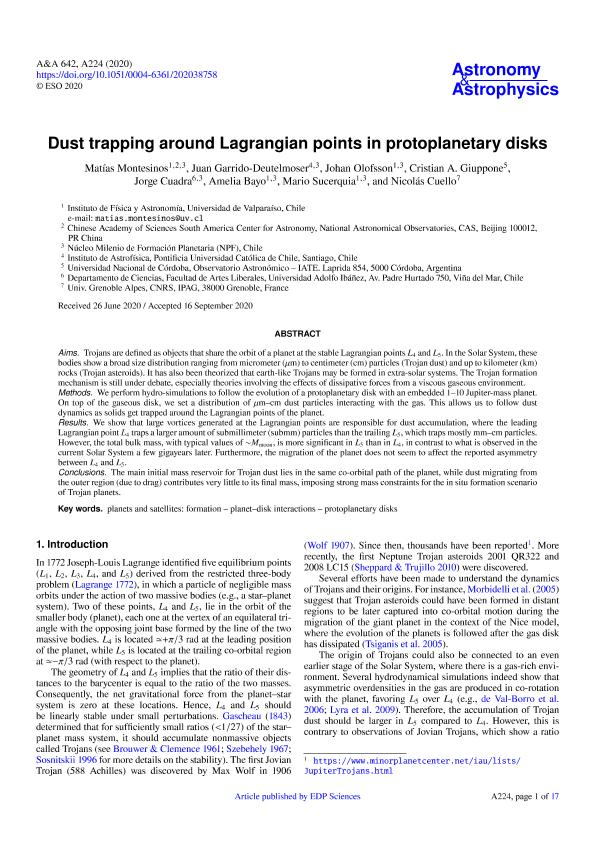Artículo
Dust trapping around Lagrangian points in protoplanetary disks
Montesinos, Matías; Garrido-Deutelmoser, Juan; Olofsson, Johan; Giuppone, Cristian Andrés ; Cuadra, Jorge; Bayo, Amelia; Sucerquia, Mario; Cuello, Nicolás
; Cuadra, Jorge; Bayo, Amelia; Sucerquia, Mario; Cuello, Nicolás
 ; Cuadra, Jorge; Bayo, Amelia; Sucerquia, Mario; Cuello, Nicolás
; Cuadra, Jorge; Bayo, Amelia; Sucerquia, Mario; Cuello, Nicolás
Fecha de publicación:
10/2020
Editorial:
EDP Sciences
Revista:
Astronomy and Astrophysics
ISSN:
0004-6361
e-ISSN:
1432-0746
Idioma:
Inglés
Tipo de recurso:
Artículo publicado
Clasificación temática:
Resumen
Trojans are defined as objects that share the orbit of a planet at the stable Lagrangian points L4 and L5. In the Solar System, these bodies show a broad size distribution ranging from micrometer (μm) to centimeter (cm) particles (Trojan dust) and up to kilometer (km) rocks (Trojan asteroids). It has also been theorized that earth-like Trojans may be formed in extra-solar systems. The Trojan formation mechanism is still under debate, especially theories involving the effects of dissipative forces from a viscous gaseous environment. Methods. We perform hydro-simulations to follow the evolution of a protoplanetary disk with an embedded 1-10 Jupiter-mass planet. On top of the gaseous disk, we set a distribution of μm-cm dust particles interacting with the gas. This allows us to follow dust dynamics as solids get trapped around the Lagrangian points of the planet. Results. We show that large vortices generated at the Lagrangian points are responsible for dust accumulation, where the leading Lagrangian point L4 traps a larger amount of submillimeter (submm) particles than the trailing L5, which traps mostly mm-cm particles. However, the total bulk mass, with typical values of ~Mmoon, is more significant in L5 than in L4, in contrast to what is observed in the current Solar System a few gigayears later. Furthermore, the migration of the planet does not seem to affect the reported asymmetry between L4 and L5. Conclusions. The main initial mass reservoir for Trojan dust lies in the same co-orbital path of the planet, while dust migrating from the outer region (due to drag) contributes very little to its final mass, imposing strong mass constraints for the in situ formation scenario of Trojan planets.
Archivos asociados
Licencia
Identificadores
Colecciones
Articulos(IATE)
Articulos de INST.DE ASTRONOMIA TEORICA Y EXPERIMENTAL
Articulos de INST.DE ASTRONOMIA TEORICA Y EXPERIMENTAL
Citación
Montesinos, Matías; Garrido-Deutelmoser, Juan; Olofsson, Johan; Giuppone, Cristian Andrés; Cuadra, Jorge; et al.; Dust trapping around Lagrangian points in protoplanetary disks; EDP Sciences; Astronomy and Astrophysics; 642; 10-2020; 1-17
Compartir
Altmétricas



